Paro Taktsang Monastery.
Taktsang is one of the holiest places in Bhutan the monastery is perched on a high granite cliff overlooking the northern Paro valley. This place is especially venerated because of its association with Guru Rinpoche, who is said to have flown to Paro Taktsang in the form of Dorji Drolo, mounted on a flaming dakini-tigress in the 747A.D.
Guru visited Bhutan for 3 times. His first visit to Bhutan 746 A.D from India was when he was invited to Bumthang to treat the Sindhu Raja, the ruler of Bumthang, who was seriously ill. The king was cured and was converted to Buddhism. He promised to return to Bhutan again to further propagate the Buddhist teachings.
A year later, Guru was invited to Tibet by King Thrisong Deutsen to assist him in the construction of the Samye Monastery. He traveled to Tibet, by tantric powers, he cleared away the demonic forces that were disturbing the construction of the monastery, and so the monastery was successfully completed.
During this visit in 747 A.D to Tibet, Guru Rinpoche decided to visit Bhutan again with his Tibetan consort Khandro Y eshi Tshogyel and Denma Tsemang. He travelled all over the country and blessed the people.
While in Singye Dzong inKurtoe, Guru is believed to have flown to Paro Taktsang in the form of Guru Dorji Drolo, the 8th and the final aspect that he assumed, mounting on a dakini-tigress. Before his arrival, the whole country was believed to have been inhabited by hostile evil spirits. On his arrival, he subdued eight categories of evil spirits and bounded them by solemn oath to be the protectors of teaching for all times to come.
He also concealed various forms of Dharma treasures including 3 teachings of Yoga to be discovered later by his disciples called Tertons (Treasure Discoverers). According to his biography ‘Yidkyi Munsel’, he meditated there for 4 months and blessed this place as the best among the sacred places (Ney).
Guru Rinpoche or Padmasambavha
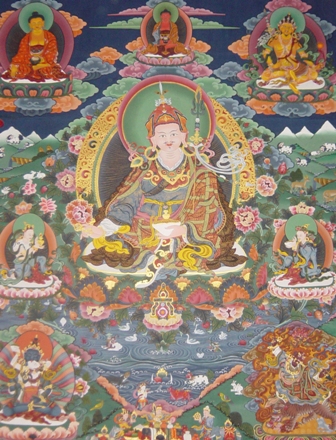 He revealed the real form of Phurpai Kyilkhor (Vajrakiliya) and instructed upon Langchen Pelgyi Singye, one of his principle disciples (Gyalbang Nyernga) and his spiritual condort Khando Yeshi Tshogyel. The cave where Guru Rinpoche and many other renowned saints meditated is called “Drubkhang” (meditation room) or the “pelphug” (holy cave)
He revealed the real form of Phurpai Kyilkhor (Vajrakiliya) and instructed upon Langchen Pelgyi Singye, one of his principle disciples (Gyalbang Nyernga) and his spiritual condort Khando Yeshi Tshogyel. The cave where Guru Rinpoche and many other renowned saints meditated is called “Drubkhang” (meditation room) or the “pelphug” (holy cave)
In Tibet at Chimphu, Guru gave initiations of the Kagyed text to his faithful disciples. His heart-disciple Langchen Pelgyi Singye who became renowned especially in the craft of subduing evil spirits was instructed to return to Paro Taktsang. Langchen Pelgyi Singye came to Taktsang in 853 A.D, and meditated in the Drubkhang for a long time. The place came to be known as Taktsang Pelphug after him. Then he went to Nepal and before dying, entrusted his body to the protector Damchen Dorji Legpa as his spiritual assistant. His body was brought back to Taktsang by Damchen Dorji Legpa and was hidden in the manner of a treasure (Terma) to be discovered later. His body is now enshrined in the deep rocks under the site of his Kudung chorten, which had been built years ago and was restored in 1982-1983.
According to the Neyig of Taktsang, compiled by Lopen Pemala, there are 9 holy caves (Phug) around the Taktsang, namely
1. Machiphug
2. Singyephug
3. Pelphug
4. Drolophug
5. Yoeselphug
6. Gadigphug
7. Choegyelphug
8. Kapaliphug
9. Phagmoiphug
Machigphug is the cave where Machig Lhabdron, incarnation of Khandro Yeshi Tshogyel, had meditated and is located above the ravine, before approaching the main Taktsang Goenpa. Singyephug can be seen nearby the small stream falling from the cliff. The stream is called Shelkarchu as it is believed that the string of glass beads were scattered around that area by Khandro Yeshi Tshogyel. The cave where Langchen Pelgyi Singye had meditated is called Pelphug seen in the main Taktsang monastery. Rest of the holy caves are said to be located somewhere behind the temple of Singye Samdrup, the protector deity of Taktsang.
Taktsang was under the charge of the Kathogpa lama since 14th century. Kathogpa lam Yeshi Bum (1245-1311), lived in the 15th century visited Taktsang where he intended to build a temple. His wish remained unfulfilled until 1508 when his nephew and disciple, Sonam Gyaltshen built the temple of Ugyen Tsemo above Taktsang.
In 1646, Zhabdrung invited Lopon Rigzin Nyingpo, the descedent of Terton Sangye Lingpa (1340-1396) from Kongpo in Tibet. Zhabdrung visited Taktsang in the company of Lopon Rigzin Nyingpo and took over the charge of Taktsang including Ugyen Tsemo from Kathogpa Lama.he appointed Jinpa Gyalthsen, brother of Desi Tenzin Rabgye, as Lama of Taktsang. Zhabdrung and Lopon Rigzin Nyingpo performed the prayer of Phurpai Kyikhor, which had been performed since then.
It is said that even though Zhabdrung had a wish to build a temple at the site where the Taktsang now stands, he could not as the construction of Paro Rinpung Dzong was underway. So he instructed Tenzin Rabgye, who was a minor at that time to build a temple. In 1692, on the command of Desi Tenzin Rabgye, the Paro Penlop Dragpa Gyaltshen built the main 2-stored temple around the Drubkhang in Taktsang and thus fulfilled Zhabdrung’s wish. It was from this time at Taktsang that system of performing annual prayer dedicated to Guru Rinpoche was introduced, which is even to this day conducted by the Tshenyid Division of the Central monastic Body.
Through numerous renovations and expansions over the following centuries, Taktsang grew into an intricate complex; some of its individual buildings are connected only by steep ladder ways. Between 1961 and 1965, the 34th Je Khenpo Sherdrup Yoezer renovated it. The latest additions were made between 1981 and 1982.
Different temples in Taktsang
• On the left of the entrance stair is the building which contains the Kudung ‘stupa’ of Langchen Pelgyi Singye whose body has been placed deep in the rocks under the site of the Kudung Chorten.
• On the inner left corner is the Dorlo Lhakhang, the temple dedicated to Guru Dorji Dorlo, which had been installed by Late Lama Sonam Zangpo. In the main building, there are three temples.
• The lower temple contains the cave where Guru Rinpoche and Pelgyi Singye meditated and contains a statue of Guru Dorji Drolo and statues of Phurpai Kyilkhor, which was said to have been erected by Niwari artisan Pentsa Dewa during the reign of Desi Tenzin Rabgye and of celestial palace of Guru Rinpoche (Zangtopelri).
• The middle temple “Guru Sungjoen Temple", temple of Guru who speaks because it is believed that when it is being transported to Taktsang, the statue of Guru spoke (sung)by itself. The most skilled artisans from Nepal, Pentsa Dewa, Dharma and Dharmashri erected the statue of Guru Sungjoen. This temple contains among other beautiful paintings of the eight manifestation of Guru, the cycle of Lama Gongdue and Tshepamed, the god of longevity.
• The upper temple “The Temple of the eight manifestations of Guru Rinpoche" was built under the auspices of Myangmed Chungpo from Paro and contains other intresting mural paintings. One of them depicts vividly how Zhabdung Ngawang Namgyel vanquished his Tibetan enemies.
• Another building includes a temple dedicated to Singye Samdrup, the protector deity of Taktsang, Tshepamed, the god of longevity and Namthoesey (Vaosravana or Kubera), and god of wealth.
It is believed that more merit is gained if we meditate one minute in Taktsang than to meditate months together in other sacred places. Its sacred essence is that of Drubkhang/Pelphug, the holy cave in which Guru Rinpoche and many other renowned saints meditated, and also the body of Langchen Pelgyi Singye had been placed deep in the rocks under the site of Kudung Chorten. The Drubkhang is opened once a year during an annual ceremony, which is performed by the monk body for 21 days in the fifth Bhutanese month.
• The literary translation of the Bhutanese word Taktsang; Tak meaning ‘tiger’ and Tshang for ‘nest’, meaning “Tiger’s Nest?.
• Located at 2950m, it is the most famous and sacred hanging cliff monastery in Bhutan.
• Seen from the road while heading towards Drukgyel Dzong (Ruined Fortress).
• Thangthong Gyalpo (1385-1464), the Iron bridge builder, also meditated here and discovered a Terma ‘treasure text’.
• Milarepa (1040-1123) is also said to have meditated in Taktsang.
• A hike to this temple from the riverbed below would normally take about 2-3 hours.
• Ponies can also be arranged till the viewpoint of the temple.
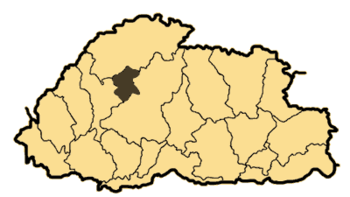
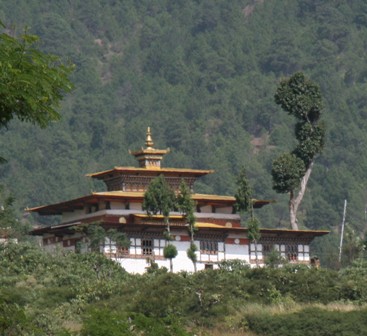
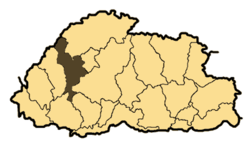
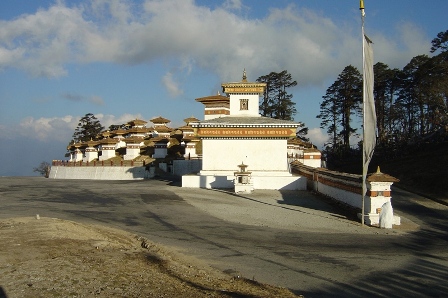
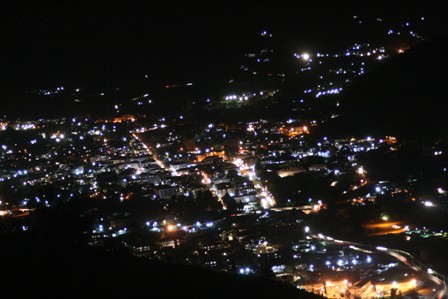 Nightshot of Thimphu
Nightshot of Thimphu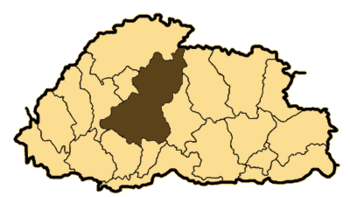 Wangdue Phodrang (previously spelled Wangdi Phodrang) is a dzongkhag (district), of central Bhutan. This is also the name of the dzong (built in 1638) which dominates the district, and the name of the small market town outside the gates of the dzong. The name is said to have been given by the Shabdrung Ngawang Namgyal who was searching for the best location for a dzong to prevent incursions from the south. At the chosen spot the Shabdrung encountered a boy named Wangdi playing beside the river and hence named the dzong “Wangdi’s Palace”.
Wangdue Phodrang (previously spelled Wangdi Phodrang) is a dzongkhag (district), of central Bhutan. This is also the name of the dzong (built in 1638) which dominates the district, and the name of the small market town outside the gates of the dzong. The name is said to have been given by the Shabdrung Ngawang Namgyal who was searching for the best location for a dzong to prevent incursions from the south. At the chosen spot the Shabdrung encountered a boy named Wangdi playing beside the river and hence named the dzong “Wangdi’s Palace”.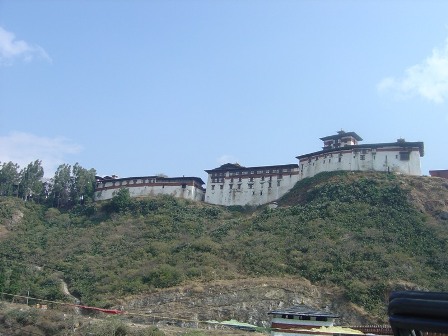 Wangdue Phodrang Dzong
Wangdue Phodrang Dzong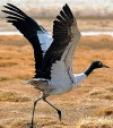
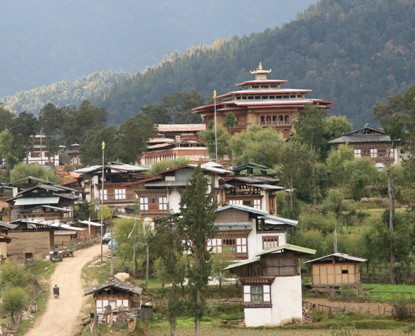 Gangtey Gompa /
Gangtey Gompa / 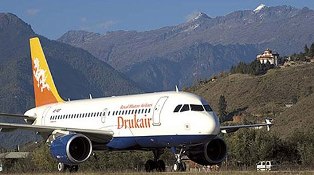 As required by government regulations all visitors must travel at least one way into Bhutan by Royal Bhutan Airlines,
As required by government regulations all visitors must travel at least one way into Bhutan by Royal Bhutan Airlines, 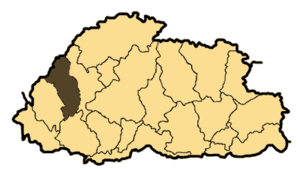
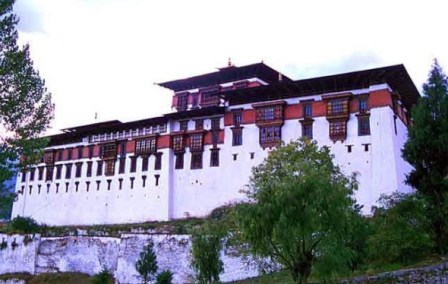
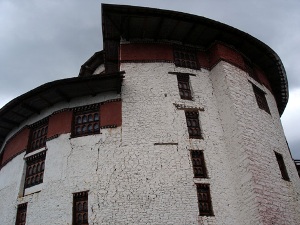 The National Museum of Bhutan, where visitors can learn about the culture of Bhutan.
The National Museum of Bhutan, where visitors can learn about the culture of Bhutan.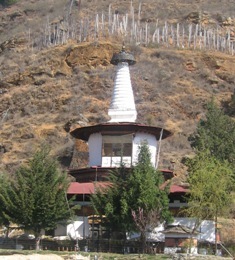 Dungtse Lhakhang
Dungtse Lhakhang He revealed the real form of Phurpai Kyilkhor (Vajrakiliya) and instructed upon Langchen Pelgyi Singye, one of his principle disciples (Gyalbang Nyernga) and his spiritual condort Khando Yeshi Tshogyel. The cave where Guru Rinpoche and many other renowned saints meditated is called “Drubkhang” (meditation room) or the “pelphug” (holy cave)
He revealed the real form of Phurpai Kyilkhor (Vajrakiliya) and instructed upon Langchen Pelgyi Singye, one of his principle disciples (Gyalbang Nyernga) and his spiritual condort Khando Yeshi Tshogyel. The cave where Guru Rinpoche and many other renowned saints meditated is called “Drubkhang” (meditation room) or the “pelphug” (holy cave)

